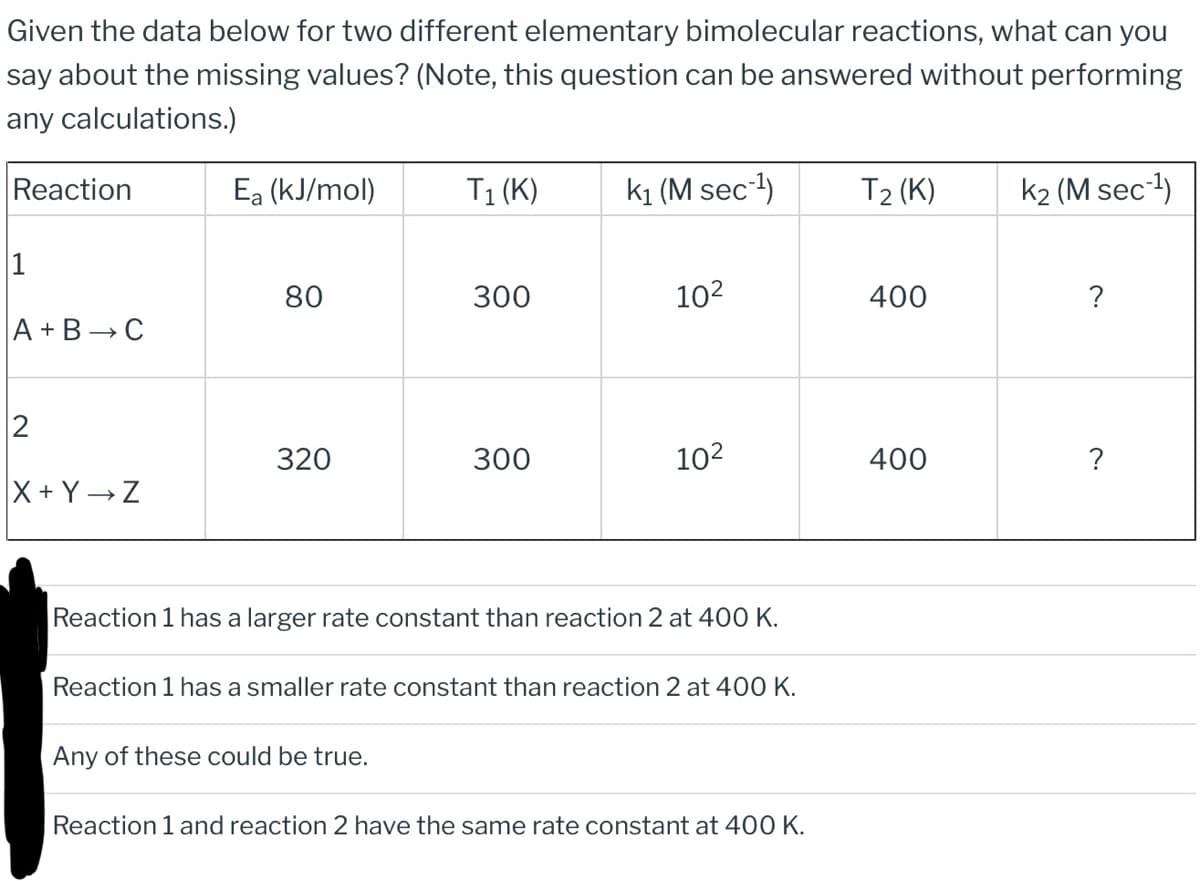Given the data below for two different elementary bimolecular reactions, what can you say about the missing values? (Note, this question can be answered without performing any calculations.) Reaction 1 A+B C 2 X+Y→Z Ea (kJ/mol) 80 320 T₁ (K) 300 Any of these could be true. 300 k₁ (M sec-¹) 10² 10² Reaction 1 has a larger rate constant than reaction 2 at 400 K. Reaction 1 has a smaller rate constant than reaction 2 at 400 K. Reaction 1 and reaction 2 have the same rate constant at 400 K. T₂ (K) 400 400 K₂ (M sec-¹) ? ?
Given the data below for two different elementary bimolecular reactions, what can you say about the missing values? (Note, this question can be answered without performing any calculations.) Reaction 1 A+B C 2 X+Y→Z Ea (kJ/mol) 80 320 T₁ (K) 300 Any of these could be true. 300 k₁ (M sec-¹) 10² 10² Reaction 1 has a larger rate constant than reaction 2 at 400 K. Reaction 1 has a smaller rate constant than reaction 2 at 400 K. Reaction 1 and reaction 2 have the same rate constant at 400 K. T₂ (K) 400 400 K₂ (M sec-¹) ? ?
Chemistry for Engineering Students
4th Edition
ISBN:9781337398909
Author:Lawrence S. Brown, Tom Holme
Publisher:Lawrence S. Brown, Tom Holme
Chapter11: Chemical Kinetics
Section: Chapter Questions
Problem 11.48PAE: 11.48 The following data were collected for the decomposition of NT),-: Time, f (min) [N2Os] (mol...
Related questions
Question
.

Transcribed Image Text:Given the data below for two different elementary bimolecular reactions, what can you
say about the missing values? (Note, this question can be answered without performing
any calculations.)
Reaction
1
A+B C
2
X+Y→Z
Ea (kJ/mol)
80
320
T₁ (K)
300
Any of these could be true.
300
k₁ (M sec-¹)
10²
10²
Reaction 1 has a larger rate constant than reaction 2 at 400 K.
Reaction 1 has a smaller rate constant than reaction 2 at 400 K.
Reaction 1 and reaction 2 have the same rate constant at 400 K.
T₂ (K)
400
400
k₂ (M sec-¹)
?
Expert Solution
This question has been solved!
Explore an expertly crafted, step-by-step solution for a thorough understanding of key concepts.
Step by step
Solved in 4 steps with 3 images

Knowledge Booster
Learn more about
Need a deep-dive on the concept behind this application? Look no further. Learn more about this topic, chemistry and related others by exploring similar questions and additional content below.Recommended textbooks for you

Chemistry for Engineering Students
Chemistry
ISBN:
9781337398909
Author:
Lawrence S. Brown, Tom Holme
Publisher:
Cengage Learning

Chemistry by OpenStax (2015-05-04)
Chemistry
ISBN:
9781938168390
Author:
Klaus Theopold, Richard H Langley, Paul Flowers, William R. Robinson, Mark Blaser
Publisher:
OpenStax

Chemistry: An Atoms First Approach
Chemistry
ISBN:
9781305079243
Author:
Steven S. Zumdahl, Susan A. Zumdahl
Publisher:
Cengage Learning

Chemistry for Engineering Students
Chemistry
ISBN:
9781337398909
Author:
Lawrence S. Brown, Tom Holme
Publisher:
Cengage Learning

Chemistry by OpenStax (2015-05-04)
Chemistry
ISBN:
9781938168390
Author:
Klaus Theopold, Richard H Langley, Paul Flowers, William R. Robinson, Mark Blaser
Publisher:
OpenStax

Chemistry: An Atoms First Approach
Chemistry
ISBN:
9781305079243
Author:
Steven S. Zumdahl, Susan A. Zumdahl
Publisher:
Cengage Learning


Chemistry
Chemistry
ISBN:
9781305957404
Author:
Steven S. Zumdahl, Susan A. Zumdahl, Donald J. DeCoste
Publisher:
Cengage Learning

Principles of Modern Chemistry
Chemistry
ISBN:
9781305079113
Author:
David W. Oxtoby, H. Pat Gillis, Laurie J. Butler
Publisher:
Cengage Learning